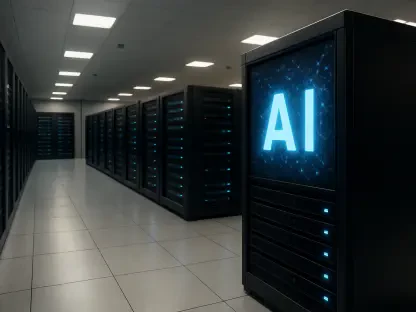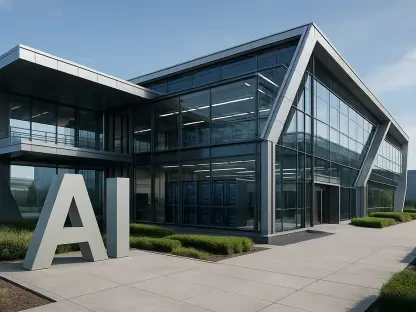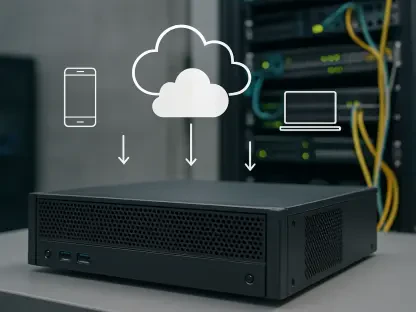In an era where artificial intelligence is pushing the boundaries of computational demand, Huawei has stepped into the spotlight with a transformative solution that could redefine cloud infrastructure. At a major industry event this year, the tech powerhouse introduced its SuperPod architecture, a groundbreaking approach to managing computing resources at an unprecedented scale. Unlike traditional cloud setups that struggle with inefficiencies as they scale, this innovation integrates thousands of physical servers into a single logical system, promising to eliminate performance bottlenecks for AI workloads. With the ever-growing complexity of AI models requiring immense processing power, Huawei’s announcement arrives as a timely response to a critical industry challenge. This development not only showcases technical prowess but also signals a strategic push to lead in the rapidly evolving cloud computing landscape. As the demand for seamless, scalable solutions intensifies, the SuperPod architecture stands out as a potential game-changer, setting the stage for a deeper exploration of its features, implications, and industry impact.
Revolutionizing Cloud Systems with SuperPod Technology
Huawei’s latest innovation, revealed at a significant tech gathering this year, centers on the SuperPod architecture, a system designed to address the persistent scaling issues plaguing cloud AI infrastructure. By unifying thousands of servers into one cohesive entity, this technology overcomes the diminishing returns often experienced when expanding traditional setups. The core idea is to ensure that computational power increases proportionally with added hardware, a feat made possible through advanced interconnect solutions. This unified design marks a departure from fragmented server clusters, offering a streamlined approach that could redefine how data centers operate. For industries reliant on heavy AI computations, such as autonomous systems and large-scale data analytics, this promises a significant leap in efficiency. The architecture’s ability to handle massive workloads without the usual performance penalties positions it as a pivotal advancement in cloud technology.
At the heart of this breakthrough lies the UnifiedBus interconnect protocol, a technical marvel that ensures low-latency, high-bandwidth connectivity across extensive data center environments. This protocol leverages optical interconnects that boast reliability far surpassing conventional systems, with fault detection capabilities as rapid as 100 nanoseconds. Such features guarantee that even minor disruptions have negligible impact on application performance, a crucial factor for AI tasks requiring constant coordination across vast server arrays. The ability to maintain seamless communication over long distances within data centers—up to 200 meters—further enhances its appeal for large-scale deployments. This technical foundation not only supports the linear scaling Huawei claims but also addresses a fundamental challenge in modern computing: ensuring reliability without sacrificing speed. As AI workloads grow increasingly complex, this interconnect technology could become a cornerstone of future cloud infrastructure.
A Versatile Product Portfolio for Diverse Needs
Huawei has strategically crafted a range of SuperPod offerings to meet the varying demands of different market segments, from small enterprises to massive cloud providers. The Atlas 850, for instance, provides an accessible, air-cooled solution tailored for businesses looking to adopt advanced AI capabilities without overhauling existing infrastructure. Capable of supporting up to 1,024 neural processing units across flexible setups, it lowers the entry barrier for private cloud adoption. On the other end of the spectrum, the Atlas 950 and 960 are built for hyperscale environments, with the latter projected to achieve up to 60 EFLOPS in FP4 precision by Q4 2027. These systems are engineered for the most demanding AI models, potentially handling trillions of parameters with ease. This diversity in product design reflects a thoughtful approach to addressing specific user needs while maintaining high performance standards across the board.
Beyond specialized AI applications, Huawei extends the SuperPod’s utility to general-purpose computing through the TaiShan 950 model. This variant focuses on enhancing performance for databases and virtualized environments, reportedly delivering improvements of up to 2.9 times over traditional architectures when integrated with Huawei’s GaussDB. Such versatility makes the technology appealing to a broader audience, including enterprises modernizing their IT frameworks for non-AI workloads. By catering to both cutting-edge AI demands and conventional computing tasks, the TaiShan 950 underscores Huawei’s ambition to be a comprehensive solution provider in the cloud space. This dual focus could accelerate adoption among organizations seeking unified platforms that support varied operational requirements, potentially reshaping how enterprise IT strategies are formulated in the coming years.
Scaling New Heights with SuperClusters and Open Collaboration
Huawei’s vision for hyperscale computing takes form in its SuperClusters, which combine multiple SuperPods into colossal systems boasting over a million neural processing units and zettaFLOPS-level performance. These setups are designed to integrate with existing data center networks through protocols like UBoE (UnifiedBus over Ethernet), ensuring compatibility while promising reduced latency and hardware costs compared to alternatives. This scalability is particularly significant for cloud providers managing massive AI workloads, where efficiency and cost-effectiveness are paramount. The ability to deploy such extensive systems without requiring complete infrastructure overhauls could position Huawei as a leader in the hyperscale market, catering to the needs of global tech giants and emerging AI-driven industries alike. The SuperCluster concept represents a bold step toward future-proofing cloud infrastructure against the exponential growth of computational demands.
Equally compelling is Huawei’s commitment to fostering an open ecosystem by releasing UnifiedBus 2.0 as an open standard by the end of this year. This initiative aims to lower barriers for partners and developers to create customized SuperPod solutions, encouraging widespread innovation and adoption across various sectors. Early evidence of real-world applicability comes from the deployment of over 300 Atlas 900 A3 units in industries such as finance, manufacturing, and telecommunications, demonstrating tangible benefits beyond theoretical promises. By prioritizing collaboration over proprietary control, Huawei seeks to build a vibrant community around its technology, potentially accelerating the development of tailored cloud solutions. This open approach could redefine industry dynamics, making advanced infrastructure more accessible and adaptable to diverse operational contexts.
Navigating Challenges Through Strategic Design
Amid semiconductor manufacturing constraints in mainland China, Huawei has turned to architectural innovation as a means to sustain competitive performance with the SuperPod technology. As articulated by company executives, this shift focuses on optimizing system design and interconnects rather than relying solely on cutting-edge chip advancements. Such a strategy offers a sustainable path for achieving high computational power using available resources, providing a model for other markets facing similar hardware limitations. This pivot highlights a broader trend in the tech industry, where software and system-level innovations are increasingly seen as viable alternatives to raw hardware progress. For Huawei, this approach not only addresses immediate challenges but also positions the company as a pioneer in redefining how performance is achieved under constrained conditions.
The implications of this strategic focus extend beyond technical solutions to influence market positioning. By emphasizing architectural ingenuity, Huawei demonstrates resilience in navigating external barriers, potentially gaining favor in regions where access to the latest semiconductor nodes is restricted. This adaptability could resonate with cloud providers and enterprises seeking cost-effective yet powerful alternatives to traditional hardware-dependent models. Furthermore, it underscores a critical insight: that breakthroughs in system integration can sometimes rival the impact of chip-level advancements. As global supply chains and geopolitical factors continue to shape technology access, Huawei’s emphasis on design over hardware dependency may serve as a blueprint for sustainable innovation in the cloud computing arena.
Redefining the Future of Cloud Infrastructure
Huawei’s SuperPod architecture signals a transformative shift toward deeply integrated cloud systems, moving away from the loosely coupled clusters that dominate current setups. For cloud service providers, the compatibility with existing Ethernet infrastructure through protocols like UBoE presents an opportunity to upgrade without the need for extensive replacements, potentially cutting costs and deployment times. This seamless integration is crucial for maintaining operational continuity while adopting next-generation technology. Additionally, the focus on unified systems addresses long-standing inefficiencies in server communication, offering a more cohesive framework for managing AI-driven workloads. As the industry grapples with the escalating complexity of computational tasks, this approach could set a new standard for scalability and performance in cloud environments.
For enterprises, particularly those with limited resources for infrastructure overhauls, models like the Atlas 850 provide a pragmatic entry point to advanced cloud AI capabilities. By offering air-cooled solutions that sidestep the complexities of specialized cooling systems, Huawei lowers adoption barriers for mid-sized organizations looking to leverage AI in private clouds. This accessibility could spur wider uptake of cutting-edge technology among businesses previously constrained by cost or technical requirements. Moreover, the broader market impact lies in how such innovations might alter competitive dynamics, especially in regions with restricted access to the latest hardware. Huawei’s emphasis on system-level advancements over chip technology suggests a future where architectural solutions play a central role in leveling the playing field for cloud infrastructure development.
Reflecting on a Groundbreaking Milestone
Huawei’s introduction of the SuperPod architecture at a landmark event this year marked a defining moment in the evolution of cloud AI infrastructure. The technology’s ability to unify vast server arrays into singular systems tackled critical inefficiencies, while the UnifiedBus protocol delivered unmatched connectivity and reliability. A diverse product range catered to both enterprise and hyperscale needs, and the ambitious SuperClusters pushed the boundaries of computational scale. The commitment to open standards through UnifiedBus 2.0 fostered collaboration, with early deployments validating real-world impact across multiple sectors. Looking ahead, the industry should closely monitor the long-term performance of these systems, especially at hyperscale levels, to assess their full potential. Stakeholders are encouraged to explore partnerships and custom solutions built on this open framework, ensuring that the benefits of such innovation reach diverse applications. As cloud demands continue to soar, Huawei’s strategic focus on architectural design offers valuable lessons for sustainable progress in constrained environments, paving the way for a more integrated and efficient future in computing.









